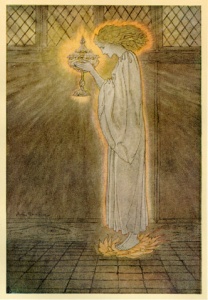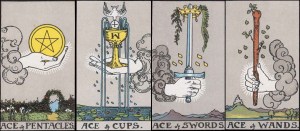Is a picture worth a thousand words? In our modern society, most are acquainted with Tarot cards as a form of divination or fortune telling. However, there is a deeper, more esoteric meaning attached to the Tarot. A legend exists related to the Tarot which tells of a group of adepts traveling through an enchanted forest. Along the way, these individuals lost their voices and were only able to communicate with each other by displaying Tarot cards to one another. Through the exercise of relation via symbols, the adepts were able to navigate out of the forest and into the light. What is the Tarot, and what relationship does the Tarot have with Freemasonry?
The Tarot System
On a surface level, the Tarot is a deck of 78 cards, each with its own distinct image and meaning. While many have used the cards as a divination tool, Tarot cards can also represent a mysterious oracle of hidden knowledge. The Tarot cards are divided into two separate groups: the Major Arcana and the Minor Arcana. The Minor Arcana consists of 56 cards divided into 4 suits: Wands, Cups, Swords, and Pentacles, and 4 court cards: Page, Knight, King, and Queen.
The meaning of the Arcana represents “what is necessary to know, to discover, to anticipate, so as to be fruitful and creative in one’s possible endeavors.” Arcana is derived from the Latin words “Arca,” meaning “Chest” and “Arcere” meaning “To shut or to close.” Thus, Arcanum symbolically represents a tightly-closed treasure chest which holds a secret meaning.
Nobel Prize winner Herbert A. Simon provides this illuminating sentiment related to the Tarot: “a symbol is simply the pattern, made of any substance whatsoever that is used to denote, or point to, some other symbol, or object or relation between objects. The thing it points to is called its meaning.” By reading Tarot cards symbolically, each person is able to divine their own meaning and truth.
Historical Origins of the Tarot
Mystery shrouds the historical origination of the Tarot. The French scholar, Court de Gebélin, wrote that the Tarot was the one book of the ancient Egyptians that escaped the burning of the great Library of Alexandria Library. 
This book was said to contain “the purest knowledge of profound matters” possessed by the wise men of Egypt. After the library was destroyed, a group of sages met in Fez, Morocco and decided to preserve the secrets of this ancient text into pictorial form on the cards of the Tarot.
There is general consensus that the pictures on the cards represented the visual retelling of the secrets of ancient mysteries, with different accounts of the wisdom being Egyptian, Zoroastrianism, or Gnostic in tradition. The symbols depicted on the cards provided a manner to keep the secrets safe except for those prepared to receive them. The cards were brought to Europe, purportedly as a result of the Crusades, but were suppressed during the inquisition of the Catholic Church during the Middle Ages.
 Tarot and the Kabbalah
Tarot and the Kabbalah
Many esoteric scholars have sought to understand the Tarot through the Kabbalah, the mystic teachings of Judaism. Kabbalah has been translated to mean “receiving,” from God, the Eternal One. Referred to as one, the deity is actually twofold in nature including the male aspect, Adonai, and the female aspect, the Holy Shechinah. The Kabbalistic Tree of Life, displayed above, is particularly useful in understanding and interpreting the Tarot. The Tree of Life consists of ten spheres, referred to as Sefirot, which are connected by 22 different paths, expressing different interactions between the Sefirot: Kingdom, Foundation, Victory, Splendor, Victory, Beauty, Mercy, Severity, Wisdom, Understanding, and Crown. Each path corresponds to a letter of the Hebrew alphabet, which contains 22 letters. Similarly, the Tarot deck contains ten numbered cards in each Minor Arcana suit and 22 cards in the Major Arcana.
Freemasonry and The Tarot
What is the relationship between The Tarot and Freemasonry? To begin, there is the existence of a Masonic themed Tarot Cards: The Square and Compass Tarot Card Deck, which is displayed above. Deeper connections exist as well, including the symbolic journey of the initiate into Freemasonry. The Tarot has been described as symbolizing the path of initiation or a journey towards reintegration with one’s true self. “Know Thyself” is a motto of the Craft and the twenty-two cards of Tarot’s Major Arcana provide useful tools for reflection for those interested in doing the work. The cards reveal stages of an archetypal journey of man with each card representing a stage to be encountered by each individual on their life path.
Like the Tarot, Freemasonry’s origins are difficult to trace and veiled in mystery, and both systems have evolved through history,  yet their essential substance remains unchanged. The Masonic scholar, A.E. Waite, posits that the Tarot and Freemasonry are both connected to the Legend of the Holy Grail. In his book The Hidden Church of the Holy Graal, Waite presents his conclusive belief that the Tarot is the “canonical Hallows of the Graal legend,” linking the character Percival, the Fool in the Tarot deck, to the Mason in search of light.
yet their essential substance remains unchanged. The Masonic scholar, A.E. Waite, posits that the Tarot and Freemasonry are both connected to the Legend of the Holy Grail. In his book The Hidden Church of the Holy Graal, Waite presents his conclusive belief that the Tarot is the “canonical Hallows of the Graal legend,” linking the character Percival, the Fool in the Tarot deck, to the Mason in search of light.
Alternatively, the Masonic writer, Manly P. Hall argued that the Major Arcana represent the 22 chapters of the Book of Revelations: a spiritual road map to achieve oneness with God.
It has been said that individuals come to Masonry to remember what has been forgotten; that all knowledge already exists with us. Through the signs, symbols and images in Tarot, the seeker is directed to recollect the universal teaching that we are all the same in essence, each traveling the same road despite perceived differences in form.
Categories: Esotericism, History




This was extremely helpful, ND I’d like to say thank you, for sharing
LikeLiked by 1 person
I am a member of Perfect Union Lodge #10, San Antonio, Texas, and 32nd degree Scottish Rite Mason. As such, I really wish you would remove this article. It is chock full of misinformation. Please use as research instead:
1. A History of Playing Cards by Hargrave.
2. A Wicked Pack of Cards: The Origins of the Occult Tarot by Decker, DePaulis, and Dummett.
3. A History of the Occult Tarot: 1870-1970 by Decker and Dummett.
LikeLike
Reblogged this on The Journey of a Seeker and commented:
A must-read for fellow Travelers.
LikeLike
Very interesting and gave me a slightly new view into Tarot. Thank you for sharing
LikeLike